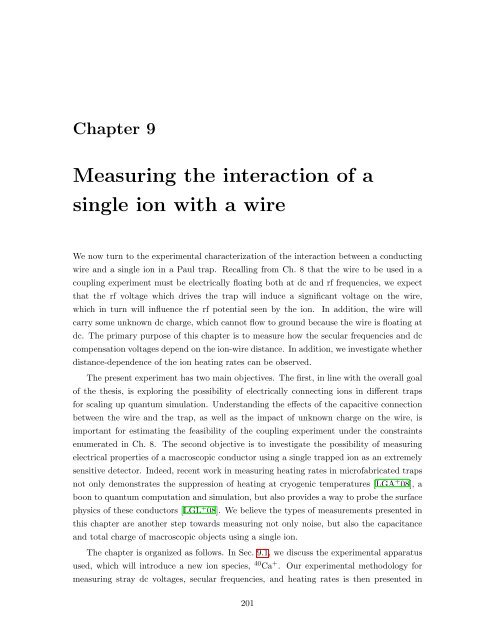Ph.D. Thesis - Physics
Ph.D. Thesis - Physics
Ph.D. Thesis - Physics
Create successful ePaper yourself
Turn your PDF publications into a flip-book with our unique Google optimized e-Paper software.
Chapter 9<br />
Measuring the interaction of a<br />
single ion with a wire<br />
We now turn to the experimental characterization of the interaction between a conducting<br />
wire and a single ion in a Paul trap. Recalling from Ch. 8 that the wire to be used in a<br />
coupling experiment must be electrically floating both at dc and rf frequencies, we expect<br />
that the rf voltage which drives the trap will induce a significant voltage on the wire,<br />
which in turn will influence the rf potential seen by the ion. In addition, the wire will<br />
carry some unknown dc charge, which cannot flow to ground because the wire is floating at<br />
dc. The primary purpose of this chapter is to measure how the secular frequencies and dc<br />
compensation voltages depend on the ion-wire distance. In addition, we investigate whether<br />
distance-dependence of the ion heating rates can be observed.<br />
The present experiment has two main objectives. The first, in line with the overall goal<br />
of the thesis, is exploring the possibility of electrically connecting ions in different traps<br />
for scaling up quantum simulation. Understanding the effects of the capacitive connection<br />
between the wire and the trap, as well as the impact of unknown charge on the wire, is<br />
important for estimating the feasibility of the coupling experiment under the constraints<br />
enumerated in Ch. 8. The second objective is to investigate the possibility of measuring<br />
electrical properties of a macroscopic conductor using a single trapped ion as an extremely<br />
sensitive detector. Indeed, recent work in measuring heating rates in microfabricated traps<br />
not only demonstrates the suppression of heating at cryogenic temperatures [LGA + 08], a<br />
boon to quantum computation and simulation, but also provides a way to probe the surface<br />
physics of these conductors [LGL + 08]. We believe the types of measurements presented in<br />
this chapter are another step towards measuring not only noise, but also the capacitance<br />
and total charge of macroscopic objects using a single ion.<br />
The chapter is organized as follows. In Sec. 9.1, we discuss the experimental apparatus<br />
used, which will introduce a new ion species, 40 Ca + . Our experimental methodology for<br />
measuring stray dc voltages, secular frequencies, and heating rates is then presented in<br />
201
















